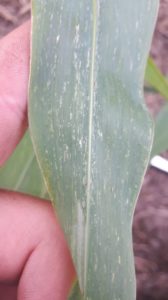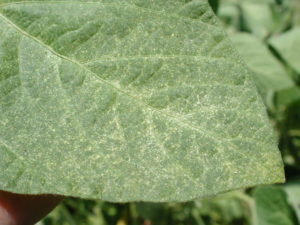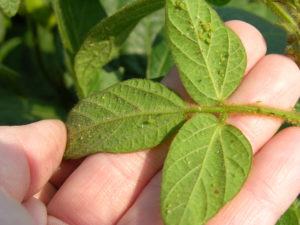While many fields have received rain over the last week, some areas are starting to show signs of stress from lack of moisture. A few pests take advantage of this situation.

Thrips in Corn and Soybeans: A number of corn fields have had high levels of thrips. Rarely are they worthy of control, except in situations where the crop is stressed due to dry conditions and can not grow out of the infestation. No thresholds exist for corn but if a decent number of thrips are present throughout the plants including new leaves AND the plants are showing symptoms of stress, a spray may be required. Recent rains helped many of the infested fields grow out of the infestations but there are still fields out there that are quite dry. I am particularly concerned if thrips infestations continue once ears start to form. Thrips activity on the ear can increase Fusarium and mycotoxin development.
Thrips are also starting to show up in soybeans, especially those areas that did not get much rain recently. Again, these infestations rarely warrant control, except when plants are showing signs of stress. Thresholds exist in other jurisdictions but usually apply for earlier season infestations. If over 75% of the trifoliates show damage and each leaf has an average of 8 thrips or more, treatment may be advisable. HOWEVER, a spray for thrips at this time could cause a flare up of spider mites or soybean aphids because it kills their natural enemies. Both pests, in my opinion, are much greater concerns than thrips. So before deciding to spray, assess plants for the presence of aphids and mites too. A good rain in infested fields should enable the plants to outgrow any thrips infestation.

Spider Mites: Despite soybean aphids always getting much of the attention, spider mites are by far more damaging. It only takes 4 mites per leaflet prior to pod fill to warrant control. And infestations often go unnoticed until much of the field is significantly impacted. Soybean aphids actually move off of heavily infested mite plants since mites begin to impact the quality of the plant, quickly leading to defoliation. Spider mite infestations tend to closely follow wheat harvest or municipal ditch bank mowing and are always associated with dry conditions. Pay particular attention to field edges, especially those bordering grasses and cereals where infestations tend to begin. Dimethoate products are the only ones that will work on spider mites. More information on spider mites can be found here: https://fieldcropnews.com/2016/08/two-spotted-spider-mites-in-edible-beans-and-soybeans/

Soybean Aphids: Soybeans are starting to enter the R1 (flowering) stage which is the start of when the soybean aphid action threshold applies. Some fields are starting to get closer to threshold so scouting is advised. These 30oC days will slow down aphid reproduction, so populations shouldn’t increase as quickly as they do in moderate temps. In my previous article I discuss the new version of the Aphid Advisor app available now, which takes into consideration the natural enemy to aphid ratio and determines if a spray is required. In lush healthy fields, the soybean aphid populations can reach closer to the Economic Injury Level of 660 aphids per plant before yield is impacted. But in drier fields, where soybean plants are short, the aphid populations should not get much past the Action Threshold of 250 aphids per plant on 80% of the plants before a spray is warranted…especially if beneficials are absent. Remember, aphids start out in hotspots in the field, so you may find the pockets where plants have 1000s of aphids on them. But plants a few feet away have hardly any. These hotspots start to redistribute across the field, resulting in only a few per plant initially. Easy for beneficials to take out. Spraying the hotspots does not make sense. Instead, make sure to take an average assessment across the field. Once 80% of the plants have reached threshold, then a spray is warranted. If there is a combination of spider mites and aphids, then dimethoate must be the product to use. More product information is available here: http://www.omafra.gov.on.ca/english/crops/pub812/pub812ch2.pdf
Pea Aphids: Some alfalfa fields have an abundant population of pea aphids in them. Rarely do they require control and thresholds are quite high, compared to leafhoppers which can have a much greater impact. That said, in dry conditions, plants can start to become stunted and yellow if thresholds are reached. It takes 50 aphids per stem on 10 inch tall plants or 100 aphids per stem on 20 inch plants to warrant control, especially in the absence of natural enemies. If leafhoppers are also present, make spray decisions based on leafhopper populations instead. With any luck, the pea aphid populations have also helped build up natural enemies that will move over to soybeans to help out there too.